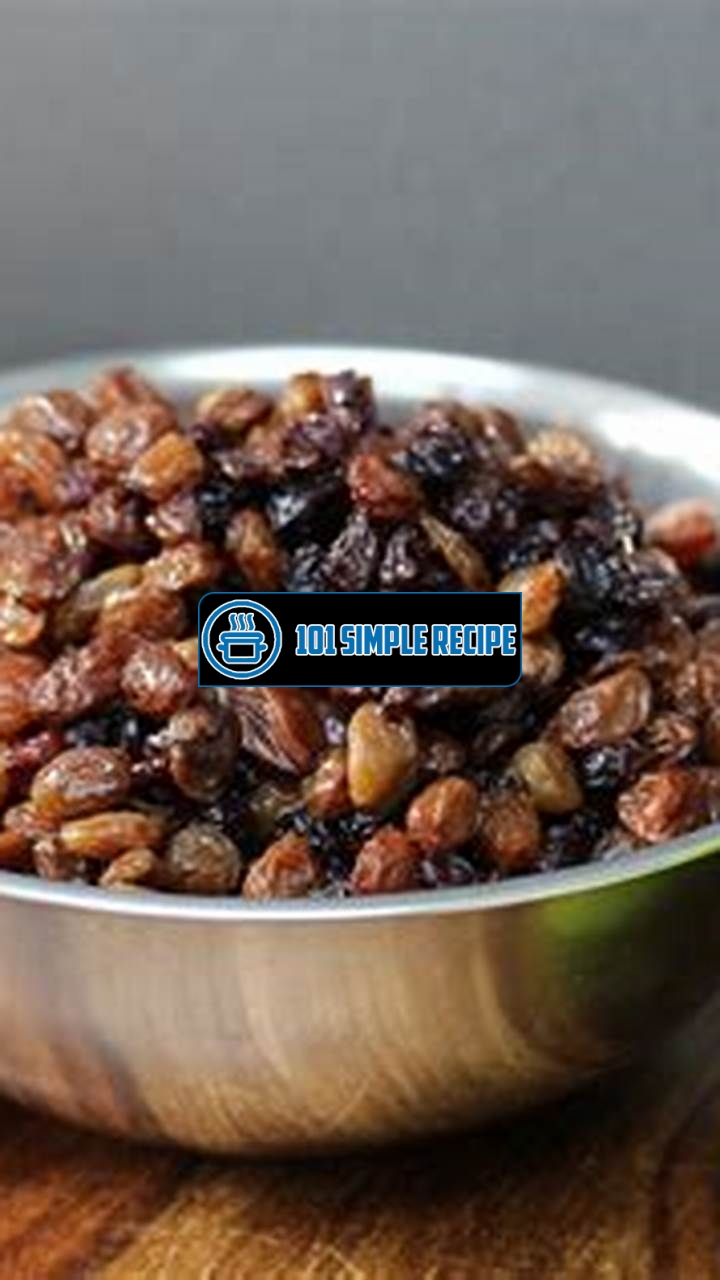Are you ready to take your culinary skills to the next level and impress your friends and family with a homemade mincemeat recipe? Look no further – we’ve got you covered! In this article, we will guide you through the process of mastering the art of homemade mincemeat with ease. Whether you’re a seasoned chef or a complete novice in the kitchen, this step-by-step guide will help you create a delicious and aromatic mincemeat that will elevate your holiday baking to new heights. So roll up your sleeves and get ready to embark on a flavor-filled journey!

The History of Mincemeat: From Medieval Times to Today
Discover the fascinating origins and evolution of mincemeat throughout history.
The Early Origins: Medieval Mincemeat
In order to truly master the art of homemade mincemeat, it’s important to understand its rich history. Mincemeat has a lineage that dates back to medieval times, where it was first concocted as a way to preserve meat during the winter months. Back then, it was typically made with finely chopped meat, such as beef or lamb, mixed with suet, dried fruits, spices, and alcohol to create a flavorful mixture that could be stored for long periods of time.
The tradition of mincemeat in medieval times reflects their practicality in finding ways to preserve meat for consumption even when fresh meat was scarce. The combination of meat, fruits, and spices created a dynamic flavor profile that was both hearty and satisfying.
Mincemeat in medieval times was commonly used to fill “coffins,” which were medieval pie crusts made of a mixture of flour and water. These pies were a popular staple during festive occasions and celebrations. The combination of savory meat and sweet dried fruits created a unique flavor experience that quickly gained popularity across Europe.
The British Influence: Mincemeat in the 18th and 19th Centuries
During the 18th and 19th centuries, mincemeat underwent a transformation in Britain. The addition of more spices, such as cinnamon, nutmeg, and cloves, became popular, giving the mincemeat a distinctive and aromatic flavor. The meat component became less prominent and was often substituted with other ingredients like suet or butter.
Mincemeat became an integral part of British culinary culture, especially during holidays like Christmas. It was during this time that traditions such as “stir-up Sunday” arose. On the last Sunday before Advent, families would gather to prepare their homemade mincemeat mixture. Each family member would take turns stirring the mixture while making a wish for good luck in the coming year.
In the 18th and 19th centuries, mincemeat also became associated with long sea voyages, as it was a popular provision for sailors due to its ability to stay fresh for extended periods. The British influence spread mincemeat across the globe during this time, and it became a beloved treat in colonial America as well.
Mincemeat Adaptations: Modern Variations and Alternatives
In modern times, mincemeat has evolved to accommodate various dietary preferences and restrictions. While the traditional recipe still remains popular, there are now vegetarian and vegan versions available that utilize ingredients like vegetable suet or coconut oil.
Modern adaptations of mincemeat have also seen the introduction of alternative fruits, such as cranberries, apricots, or figs, to add a unique twist to the traditional flavor profile. These variations offer a fresh take on this classic dish, allowing individuals to explore different tastes and textures.
Furthermore, mincemeat is no longer limited to being used solely as a pie filling. It can now be incorporated into other desserts, like cookies or cakes, or even used as a spread on toast or crackers.
By understanding the history and evolution of mincemeat, you can truly master the art of preparing this beloved dish. Whether you choose to stick to the traditional recipe or experiment with modern adaptations, there’s no doubt that mincemeat will continue to delight taste buds for generations to come.
The Art of Making Homemade Mincemeat
Uncover the step-by-step process of creating your own delicious homemade mincemeat.
Selecting the Right Meats and Fruits
When it comes to making homemade mincemeat, selecting the right meats and fruits is essential to achieving the perfect balance of flavors. You have the freedom to choose from various options, so let’s take a closer look at what you should consider.
To create a rich and savory mincemeat, you’ll want to choose meats that have a good amount of marbling, like beef or venison. These meats offer a deep and robust flavor that pairs well with the other ingredients. Make sure to finely chop or grind the meats to ensure they mix well with the other components of the mincemeat.
Next, let’s focus on the fruits. Traditionally, mincemeat contains fruits like apples, raisins, and currants. These fruits provide a sweet and tangy contrast to the savory meat. Consider using a combination of different fruits to add complexity to your mincemeat. Chop the fruits into small pieces to ensure they distribute evenly throughout the mixture.
Key point: Don’t be afraid to experiment with different meat and fruit combinations to find the perfect balance of flavors for your homemade mincemeat.
Essential Ingredients for Perfect Homemade Mincemeat
In addition to meats and fruits, there are several essential ingredients that contribute to the overall flavor and texture of homemade mincemeat. Let’s explore these ingredients in detail.
Sugar: Sugar is a crucial component of mincemeat as it provides sweetness and helps preserve the mixture. Brown sugar is often used for its rich flavor, but you can also experiment with different types of sugar, such as muscovado or demerara, for a unique twist.
Suet: Suet, the hard and white fat from around the kidneys of beef or mutton, adds richness and moisture to the mincemeat. It provides a creamy texture and helps bind the mixture together. If you prefer a vegetarian option, you can substitute suet with vegetable shortening.
Alcohol: Adding a splash of alcohol to your mincemeat not only enhances the flavor but also helps with preservation. Traditionally, brandy or rum is used, but feel free to experiment with your favorite spirits. Just remember to add it in moderation, as a little goes a long way.
Spices: A blend of aromatic spices is what gives mincemeat its distinct flavor. Common spices include cinnamon, nutmeg, cloves, and allspice. Experiment with different spice ratios to find the perfect balance that suits your taste buds.
Dried Fruit: Alongside the fresh fruits, dried fruits like currants, raisins, and sultanas are often added to enhance the sweetness and texture of the mincemeat. Soaking the dried fruits in the alcohol of your choice can also help them plump up and infuse with flavor.
Citrus Zest: The zest of oranges or lemons adds a refreshing citrusy note to the mincemeat, balancing out the richness of the other ingredients. Make sure to grate the zest finely to avoid any bitter pith.
Key point: The combination of these essential ingredients is what makes homemade mincemeat a delightful treat. Don’t be afraid to customize them to suit your taste preferences.
The Secret to a Flavorful Mincemeat Spice Blend
A well-balanced spice blend is the secret behind a flavorful mincemeat. While the choice of spices may vary, here are some commonly used ones that complement the other ingredients:
- Cinnamon: This warm and aromatic spice adds a sweet and comforting note to the mincemeat.
- Nutmeg: With its slightly sweet and nutty flavor, nutmeg enhances the overall richness of the mincemeat.
- Cloves: Cloves bring a bold and distinct flavor to the spice blend, adding depth and complexity to the mincemeat.
- Allspice: As the name suggests, allspice combines flavors of cinnamon, nutmeg, and cloves, creating a harmonious blend that elevates the mincemeat.
To create the perfect mincemeat spice blend, start with equal parts of cinnamon and nutmeg, and gradually add smaller amounts of cloves and allspice until you achieve the desired balance. You can also experiment with other spices like ginger or cardamom for additional layers of flavor.
Key point: The secret to a flavorful mincemeat lies in finding the right spice blend. Feel free to customize the ratios and even explore new spices to make your mincemeat truly unique. ️
Preserving and Storing Homemade Mincemeat
When it comes to homemade mincemeat, preserving and storing are essential steps to ensure that your creation stays fresh and flavorful for months. By following the right techniques, you can enjoy the delicious taste of your mincemeat long after its preparation.
The Role of Alcohol in Preserving Mincemeat
Alcohol plays a crucial role in preserving mincemeat. Traditionally, recipes called for the addition of spirits like brandy or rum. These alcoholic beverages not only add depth of flavor but also act as natural preservatives, helping to inhibit the growth of bacteria and fungi that can spoil the mincemeat.
Moreover, the alcohol content helps to prolong the shelf life of the mincemeat. The molecules present in the spirits interact with the ingredients, preventing spoilage and maintaining the freshness of the mixture.
Note: Adding alcohol to your mincemeat is entirely optional. If you prefer a non-alcoholic version, you can omit the spirits altogether and still achieve a delicious homemade mincemeat.
Proper Storage Techniques: Jars, Freezing, and More
Choosing the right storage technique is crucial in maintaining the quality of your homemade mincemeat. There are several options you can consider:
- 1. Sealed Jars: Transfer your mincemeat into clean, airtight jars. Make sure to leave some headspace to allow for expansion during the freezing process. Seal the jars tightly and store them in a cool, dark place, such as a pantry or cellar. This method is ideal if you plan to consume the mincemeat within a few weeks.
- 2. Freezing: Another excellent way to preserve mincemeat is by freezing it. Divide the mixture into smaller portions and place them in freezer-safe containers or resealable bags. Label them with the date of packaging and store them in the freezer. Frozen mincemeat can last for up to 12 months, maintaining both its flavor and texture.
- 3. Vacuum Sealing: If you own a vacuum sealer, consider using it to preserve your mincemeat. Vacuum sealing removes the oxygen from the packaging, preventing freezer burn or spoilage. This method also helps retain the taste and texture of the mincemeat for an extended period.
How Long Can You Keep Homemade Mincemeat?
The shelf life of homemade mincemeat can vary depending on the storage method used:
- If stored in sealed jars in a cool, dark place, homemade mincemeat can stay fresh for 2 to 4 weeks.
- Frozen mincemeat can last up to 12 months without compromising flavor and quality.
- Vacuum-sealed mincemeat, when stored correctly in the freezer, can maintain its taste and texture for up to 18 months.
It’s important to remember that these timeframes are guidelines, and the quality of the mincemeat may deteriorate over time. Always trust your senses and discard any mincemeat that appears spoiled or develops an off odor.
By understanding the importance of alcohol in preserving mincemeat and employing proper storage techniques, you can master the art of homemade mincemeat and enjoy its delectable flavors for months on end.
Sweet Treats: Delicious Mincemeat Dessert Ideas
When it comes to creating delectable desserts, homemade mincemeat is a versatile ingredient that can elevate any sweet treat. Whether you’re hosting a dinner party or simply indulging in some self-care, there are countless innovative and mouthwatering dessert recipes that make use of homemade mincemeat. Let’s dive into the world of irresistible mincemeat desserts that will leave your taste buds begging for more.
Ideas for Classic Mincemeat Pies and Tarts
Classic mincemeat pies and tarts are timeless desserts that never fail to impress. The rich and flavorful filling of mincemeat combined with the buttery pastry crust creates a heavenly combination that is hard to resist. Adding a touch of cinnamon or nutmeg to the pastry can take these traditional desserts to a whole new level of deliciousness. Remember to serve them warm with a dollop of whipped cream or a scoop of vanilla ice cream for that extra indulgence.
Important Point: Classic mincemeat pies and tarts are a must-try dessert for any lover of homemade mincemeat.
Creative Mincemeat-Filled Pastries and Cakes
If you’re feeling adventurous and want to experiment with different dessert options, why not try mincemeat-filled pastries and cakes? From flaky turnovers and Danish pastries to moist cakes and muffins, the possibilities are endless. Imagine biting into a warm mincemeat-filled croissant with a hint of orange zest or enjoying a slice of spiced mincemeat cake topped with a luscious cream cheese frosting. These creative creations will satisfy both your sweet tooth and your desire for something unique.
Important Point: Get creative and explore the world of mincemeat-filled pastries and cakes for a truly memorable dessert experience.
Unexpected Delights: Non-Traditional Mincemeat Desserts
If you’re looking to surprise your guests or simply want to try something out of the ordinary, non-traditional mincemeat desserts are sure to do the trick. How about a refreshing mincemeat ice cream made with a hint of brandy or a tangy mincemeat sorbet? These frozen delights will tantalize your taste buds and provide a unique twist to the traditional mincemeat flavors. Additionally, you can also experiment with mincemeat crumbles, trifles, or even mincemeat-stuffed crepes for a truly unconventional dessert experience.
Important Point: Step out of your comfort zone and explore the world of non-traditional mincemeat desserts for an unexpectedly delightful treat.
In conclusion, homemade mincemeat opens up a world of possibilities in the realm of dessert creation. Whether you’re a fan of classic pies and tarts, enjoy experimenting with pastries and cakes, or prefer the unexpected delights of non-traditional desserts, there’s a perfect mincemeat treat waiting to be enjoyed. Get creative, have fun, and master the art of homemade mincemeat desserts with ease!
Sharing the Love: Homemade Mincemeat Gift Ideas
When it comes to homemade mincemeat, its delightful flavors and heartwarming aroma make it the perfect gift for your loved ones. If you’re looking for thoughtful and unique ways to share your homemade mincemeat, we’ve got you covered. From hampers and gift boxes to jar labels and packaging ideas, as well as DIY mincemeat recipes for baking enthusiasts, here are some amazing ideas to inspire you.
Homemade Mincemeat Hampers and Gift Boxes
Creating homemade mincemeat hampers and gift boxes is an excellent way to present your delicious creation. Personalize your hamper by including a variety of sweet treats, such as mince pies, shortbread cookies, or even a bottle of mulled wine. Wrap everything beautifully and add a handwritten note to make it extra special. By gifting a mincemeat hamper, you’re offering a delightful culinary experience that will warm the hearts and taste buds of your loved ones.
Homemade Mincemeat Jar Labels and Packaging Ideas
Give your homemade mincemeat jars a personal touch by designing unique labels and packaging. Use attractive labels with festive designs, such as holly leaves or snowflakes, to make your jars stand out. Consider adding a creative touch, like tying a small ribbon or attaching a handwritten recipe card to the jar. These charming details will make your gift even more memorable and show your recipients the effort and love you’ve put into making the mincemeat.
DIY Mincemeat Recipes: Gift Ideas for Baking Enthusiasts
If you have friends or family members who enjoy baking, why not gift them with a DIY mincemeat recipe kit? Gather all the ingredients needed for homemade mincemeat, along with a beautifully printed recipe card. Package them in a decorative box along with baking accessories, such as festive cookie cutters or a pastry brush. This thoughtful gift will encourage your loved ones to experiment in the kitchen and create their own mincemeat masterpiece.
Now that you have these amazing homemade mincemeat gift ideas at your fingertips, it’s time to get started! Whether you opt for a hamper filled with delicious treats, personalized jar labels, or a DIY mincemeat recipe kit, your loved ones will appreciate the time and care you’ve put into these thoughtful gifts. So, roll up your sleeves, put on your apron, and create homemade mincemeat gifts that will leave a lasting impression.
Frequently Asked Questions
Before you go, here are some frequently asked questions about homemade mincemeat:
| No. | Questions | Answers |
|---|---|---|
| 1. | What is mincemeat? | Mincemeat is a traditional British filling made with a mixture of chopped dried fruits, spices, suet, and alcohol. It is commonly used as a filling for mince pies. |
| 2. | How long does homemade mincemeat last? | If stored in an airtight container in a cool, dark place, homemade mincemeat can last for up to 6 months. It is best to consume it within a year. |
| 3. | Can I use vegetarian suet in homemade mincemeat? | Yes, you can use vegetarian suet as a substitute for traditional suet in homemade mincemeat. It will yield similar results. |
| 4. | Can I make mincemeat without alcohol? | Yes, you can make mincemeat without alcohol. Simply substitute the alcohol with fruit juice or water. |
| 5. | How long does it take to make homemade mincemeat? | The process of making homemade mincemeat typically takes about 2-3 hours, including preparation and cooking time. |
| 6. | Can I freeze homemade mincemeat? | Yes, you can freeze homemade mincemeat. Just make sure to store it in an airtight container or freezer bags for up to 3 months. |
Thank You for Reading!
We hope you enjoyed learning about homemade mincemeat. Now you’re ready to try making it on your own! Don’t forget to visit us again for more delicious recipes and helpful cooking tips. Happy cooking!
Jump to Recipe
Homemade Mincemeat

Learn how to make delicious homemade mincemeat from scratch with our easy-to-follow recipe. Perfect for mince pies and other holiday treats!
- 2 cups chopped mixed dried fruits (such as raisins, currants, and mixed peel)
- 1 cup grated apple
- 1/2 cup suet
- 1/2 cup brown sugar
- 1/2 cup chopped almonds
- 1/2 cup brandy
- 1/2 teaspoon ground cinnamon
- 1/4 teaspoon ground nutmeg
- 1/4 teaspoon ground cloves
- 1/4 teaspoon salt
- In a large bowl, combine the mixed dried fruits, grated apple, suet, brown sugar, chopped almonds, brandy, ground cinnamon, ground nutmeg, ground cloves, and salt. Mix well to combine.
- Cover the bowl with cling wrap and let the mixture sit at room temperature for at least 2 hours, or overnight for the flavors to meld together.
- Transfer the mixture to sterilized jars or containers and pack it down tightly. Seal the jars or containers and store in a cool, dark place.
- Shake the jars or containers occasionally to distribute the flavors. The mincemeat will be ready to use after at least 2 weeks of maturing.






